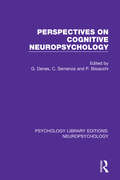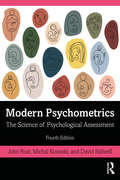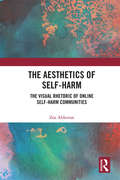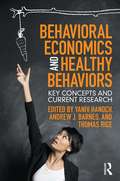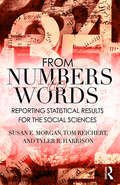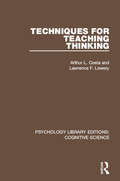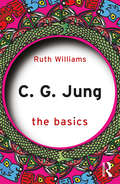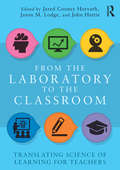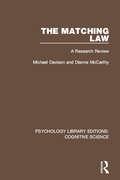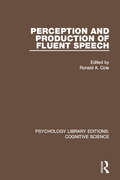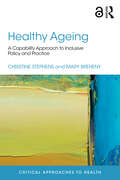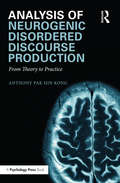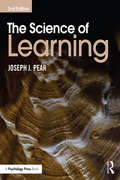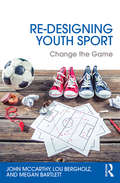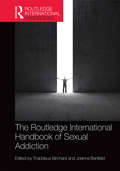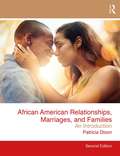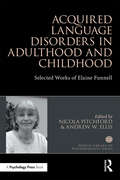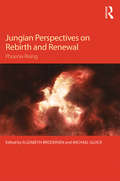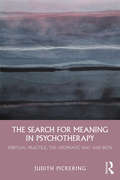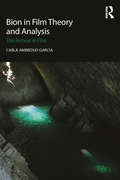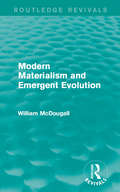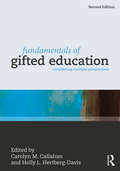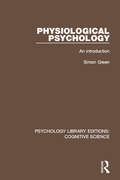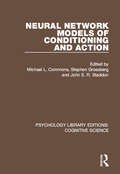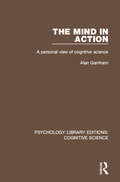- Table View
- List View
Perspectives on Cognitive Neuropsychology (Psychology Library Editions: Neuropsychology #6)
by G. Denes C. Semenza P. BisiacchiOriginally published in 1988, neuropsychology had evolved considerably in the decade prior to publication. Methods of research had changed, new topics of interests had emerged, and there had also been an ongoing debate as to the objectives of the field. This evolution had most radically affected the study of cognitive disorders – an area that had developed particularly rapidly in the years before and that ultimately became a field of inquiry in its own right, that of cognitive neuropsychology. The contributors to this volume all share a fascination with the new perspectives for understanding how the mind works that have arisen from the study of impaired cognition. Yet, and this was very characteristic of the state of the art in cognitive neuropsychology at the time, they disagreed on many important issues, even those pertaining to the most basic assumptions of their discipline. Therefore, the first part of this book is devoted to an attempt to define and clarify these basic issues and to the confrontation of alternative views. The remaining parts present original studies on several topics of particular interest in cognitive neuropsychology.
Modern Psychometrics: The Science of Psychological Assessment (International Library Of Psychology Ser.)
by John Rust Michal Kosinski David StillwellThis popular text introduces the reader to all aspects of psychometric assessment, including its history, the construction and administration of traditional tests, and the latest techniques for psychometric assessment online. Rust, Kosinski, and Stillwell begin with a comprehensive introduction to the increased sophistication in psychometric methods and regulation that took place during the 20th century, including the many benefits to governments, businesses, and customers. In this new edition, the authors explore the increasing influence of the internet, wherein everything we do on the internet is available for psychometric analysis, often by AI systems operating at scale and in real time. The intended and unintended consequences of this paradigm shift are examined in detail, and key controversies, such as privacy and the psychographic microtargeting of online messages, are addressed. Furthermore, this new edition includes brand-new chapters on item response theory, computer adaptive testing, and the psychometric analysis of the digital traces we all leave online. Modern Psychometrics combines an up-to-date scientific approach with full consideration of the political and ethical issues involved in the implementation of psychometric testing in today’s society. It will be invaluable to both undergraduate and postgraduate students, as well as practitioners who are seeking an introduction to modern psychometric methods.
The Aesthetics of Self-Harm: The Visual Rhetoric of Online Self-Harm Communities
by Zoe AldertonThe Aesthetics of Self-Harm presents a new approach to understanding parasuicidal behaviour, based upon an examination of online communities that promote performances of self-harm in the pursuit of an idealised beauty. The book considers how online communities provide a significant level of support for self-harmers and focuses on relevant case studies to establish a new model for the comprehension of the online supportive community. To do so, Alderton explores discussions of self-harm and disordered eating on social networks. She examines aesthetic trends that contextualise harmful behavior and help people to perform feelings of sadness and vulnerability online. Alderton argues that the traditional understanding of self-violence through medical discourse is important, but that it misses vital elements of human group activity and the motivating forces of visual imagery. Covering psychiatry and psychology, rhetoric and sociology, this book provides essential reading for psychologists, sociologists and anthropologists exploring group dynamics and ritual, and rhetoricians who are concerned with the communicative powers of images. It should also be of great interest to medical professionals dealing with self-harming patients.
Behavioral Economics and Healthy Behaviors: Key Concepts and Current Research
by Andrew Barnes Thomas Rice Yaniv HanochThe field of behavioural economics can tell us a great deal about cognitive bias and unconscious decision-making, challenging the orthodox economic model whereby consumers make rational and informed choices. But it is in the arena of health that it perhaps offers individuals and governments the most value. In this important new book, the most pernicious health issues we face today are examined through a behavioral economic lens. It provides an essential and timely overview of how this growing field of study can reframe and offer solutions to some of the biggest health issues of our age. The book opens with an overview of the core theoretical concepts, after which each chapter assesses how behavioral economic research and practice can inform public policy across a range of health issues. Including chapters on tobacco, alcohol and drug use, physical activity, dietary intake, cancer screening and sexual health, the book integrates the key insights from the field to both developed and developing nations. Also asking important ethical questions around paternalism and informed choice, this book will be essential reading for students and researchers across psychology, economics and business and management, as well as public health professionals wishing for a concise overview of the role behavioral economics can potentially play in allowing people to live healthier lives.
From Numbers to Words: Reporting Statistical Results for the Social Sciences
by Tom Reichert Susan Morgan Tyler R. HarrisonThis invaluable resource guides readers through the process of creating scholarly, publishable prose from the results of quantitative experiments and investigations. It delves into the issues commonly encountered when reporting the results of statistical experiments and investigations, and provides instruction re the representation of these results in text and visual formats. This unique research companion serves as a must-have reference for advanced students doing quantitative research and working with statistics, with the goal of writing up and publishing their findings; it also serves as a useful refresher for experienced researchers.
Techniques for Teaching Thinking (Psychology Library Editions: Cognitive Science)
by Lawrence F. Lowery Arthur CostaOriginally published in 1989 the purpose of this title was to provide information and ideas for: Staff Developers and Teacher Educators, as they consider program content to prepare teachers to teach thinking skills. Teachers, as they assess their own abilities to create classroom conditions for thinking and their readiness to implement a curriculum for developing thinking skills. Curriculum Developers, as they decide how the curriculum should be organized and sequenced according to children’s developmental levels. Administrators, as they assess and provide leadership for improving the conditions in their schools and classrooms, which allows the stimulating teaching of thinking. Although written some time ago the information is still valid today.
C. G. Jung: The Basics (The Basics)
by Ruth WilliamsC. G. Jung: The Basics is an accessible, concise introduction to the life and ideas of C. G. Jung for readers of all backgrounds, from those new to Jung’s work to those looking for a convenient reference. Ruth Williams eloquently and succinctly introduces the key concepts of Jungian theory and paints his biographical picture with clarity. The book begins with an overview of Jung’s family life, childhood, and relationship with (and subsequent split from) Sigmund Freud. Williams then progresses thematically through the key concepts in his work, clearly explaining ideas including the unconscious, the structure of the psyche, archetypes, individuation, psychological types and alchemy. C. G. Jung: The Basics also presents Jung’s theories on dreams and the self, and explains how his ideas developed and how they can be applied to everyday life. The book also discusses some of the negative claims made about Jung, especially his ideas on politics, race, and gender, and includes detailed explanations and examples throughout, including a chronology of Jung’s life and suggested further reading. C. G. Jung: The Basics will be key reading for students at all levels coming to Jung’s ideas for the first time and general readers with an interest in his work. For those already familiar with Jungian concepts, it will provide a helpful guide to applying these ideas to the real world.
From the Laboratory to the Classroom: Translating Science of Learning for Teachers
by John Hattie Jared Cooney Horvath Jason M. LodgeOver recent years the field of Science of Learning has increased dramatically. Unfortunately, despite claims that this work will greatly impact education, very little research makes it into teacher practice. Although the reasons for this are varied, a primary concern is the lack of a proper translation framework. From the Laboratory to the Classroom aims to consolidate information from many different research disciplines and correlate learning principles with known classroom practices in order to establish explanatory foundations for successful strategies that can be implemented into the classroom. It combines theoretical research with the diverse and dynamic classroom environment to deliver original, effective and specific teaching and learning strategies and address questions concerning what possible mechanisms are at play as people learn. Divided into five sections, chapters cover: A Framework for Organizing and Translating Science of Learning Research Motivation and Attention as Foundations for Student Learning Memory and Metamemory Considerations in the Instruction of Human Beings Science of Learning in Digital Learning Environments Educational Approaches for Students Experiencing Learning Difficulties and Developmental Characteristics of Gifted Children Brain, Behaviour and Classroom Practice Forging Research/Practice Relationships via Laboratory Schools This fascinating text gathers an international team of expert scientists, teachers, and administrators to present a coherent framework for the vital translation of laboratory research for educational practice. Applying the Science of Learning framework to a number of different educational domains, it will be an essential guide for any student or researcher in education, educational psychology, neuropsychology, educational technology and the emergent field of neuroeducation.
The Matching Law: A Research Review (Psychology Library Editions: Cognitive Science)
by Michael Davison Dianne McCarthyOriginally published in 1988, the purpose of this title was to present a coherent summary of the previous 30 years’ of research on the way in which animals and humans distribute their behaviour between alternative sources of reinforcement. There were three reasons why the book was needed at the time. First, it makes use of the empirical results available, something only partially present in many theories of the time. Second, as a general source of information to gain understanding of the scope of research on behaviour allocation. Third, a text was needed that described the techniques of experimental design and data analysis in this area.
Perception and Production of Fluent Speech (Psychology Library Editions: Cognitive Science)
by Ronald A. ColeOriginally published in 1980, this title looks at the mental processes involved in producing and understanding spoken language. Although there had been several edited volumes on speech in the previous ten years, this volume was unique in that it deals exclusively with perception and production of fluent speech. The chapters in this volume, contributed to by distinguished scientists from psychology, linguistics and computer science, deal with such questions as: How are ideas encoded into sound? How does a speaker plan an utterance? How are words recognized? What is the role of knowledge in speech perception? In short, how do people communicate with each other using speech?
Healthy Ageing: A Capability Approach to Inclusive Policy and Practice (Critical Approaches to Health)
by Christine Stephens Mary BrehenyWhat does it mean to age well? This important new book redefines what ‘successful’ ageing means, challenging the idea that physical health is the only criteria to gauge the ageing process and that an ageing population is necessarily a burden upon society. Using Sen’s Capability Approach as a theoretical starting point Healthy Ageing: A Capability Approach to Inclusive Policy and Practice outlines a nuanced perspective that transcends the purely biomedical view, recognising ideas of resilience, as well as the experiences of older people themselves in determining what it means to age well. It builds to provide a comprehensive response to the overarching discourse that successful ageing is simply about eating well and exercising, acknowledging not only that older people are not always able to follow such advice, but also that well-being is mediated by factors beyond the physical. In an era where ageing has become such an important topic for policy makers, this is a robust and timely response that examines what it means to live well as an older person. It will be hugely valuable not only for students of gerontology and social care, but also professionals working in the field.
Analysis of Neurogenic Disordered Discourse Production: From Theory to Practice
by Anthony Pak KongAnalysis of Neurogenic Disordered Discourse Production provides a comprehensive review and discussion of aphasia and its related disorders, their corresponding clinical discourse symptoms that speech-language pathologists and related healthcare professionals should address, and the different methods of discourse elicitation that are research- and clinically-oriented. Contemporary issues related to disordered/clinical discourse production are covered, and discussions of various treatment options in relation to discourse symptoms are included. Finally, the manifestation of discourse symptoms as a function of speakers’ bilingual/multilingual status and specific considerations related to clinical assessment and intervention are explored. Readers who want to learn the background and techniques of discourse analysis, refresh their knowledge of discourse production, update their knowledge of assessment and treatment of discourse production, and learn about contemporary issues of discourse annotation and analysis using existing computer software will find this book a valuable tool. With its comprehensive coverage, it offers a thorough understanding of the nature, assessment, and remediation of discourse deficits in aphasia and related disorders. Readers will also benefit from examples throughout the book that connect theory to real-life contexts of discourse production.
The Science of Learning
by Joseph J. PearFor over a century and a quarter, the science of learning has expanded at an increasing rate and has achieved the status of a mature science. It has developed powerful methodologies and applications. The rise of this science has been so swift that other learning texts often overlook the fact that, like other mature sciences, the science of learning has developed a large body of knowledge. The Science of Learning comprehensively covers this knowledge in a readable and highly systematic manner. Methodology and application are discussed when relevant; however, these aspects are better appreciated after the reader has a firm grasp of the scientific knowledge of learning processes. Accordingly, the book begins with the most fundamental and well-established principles of the science and builds on the preceding material toward greater complexity. The connections of the material with other sciences, especially its sister science, biology, are referenced throughout. Through these frequent references to biology and evolution, the book keeps in the forefront the recognition that the principles of learning apply to all animals. Thus, in the final section the book brings together all learning principles studied in research settings by demonstrating their relevance to both animals and humans in their natural settings. For animals this is the untamed environment of their niches; for humans it is any social environment, for Homo sapiens is the social and learning animal par excellence.
Re-Designing Youth Sport: Change the Game
by John McCarthy Lou Bergholz Megan BartlettMany observers have pointed out what is wrong with youth sport: an emphasis on winning at all costs; parental over-involvement; high participation costs that exclude many families; lack of vigorous physical activity; lack of player engagement; and no focus on development. Currently, most attempts at righting the wrongs of youth sport have focused on coach education and curriculum, but in this book, the authors offer a different approach—one that involves changing the game itself. Re-Designing Youth Sport combines vivid examples and case studies of innovative sport programs who are re-designing their sport with a comprehensive toolkit for practitioners on how to change their game for bigger and better outcomes. It offers a fresh and exciting perspective on the seemingly intractable issues in sport. It presents a practical and empowering pathway for readers to apply the examples and tools to the outcomes that they aspire to achieve in their sport, such as increased fun and excitement, life-skills building, gender inclusion, increased sportspersonship, greater parity and avoidance of one-sided competition, and positive parental roles. The book also reveals how community leagues as well as national and international sport governing bodies are using re-design to accelerate player skill development, tactical awareness, and physical fitness.
Routledge International Handbook of Sexual Addiction (Routledge International Handbooks)
by Thaddeus Birchard Joanna BenfieldThe concept of sexual addiction has gained increasing recognition in the academic and healthcare communities since the 1990s. It has also captured the attention of the media, where there has been much debate over whether it can truly be described as an addiction. What is certain is that many people struggle with out of control sexual behaviour, which takes over their lives and has harmful consequences for their relationships, careers and finances. The Routledge International Handbook of Sexual Addiction brings together a comprehensive range of perspectives on sexual addiction from a worldwide selection of scholars and therapists. It sets out to define sexual addiction and to study its causes from a range of different psychological perspectives. A series of presentations of sexual addiction are outlined, including internet sexual addiction and the relationship between paraphilias and sex addiction. The handbook considers both individual and group treatment strategies, drawing on a wide range of approaches, including cognitive behavioural therapy, mindfulness and 12-step programmes. The book studies sex addiction in specific populations including women, adolescents and men who have sex with men. Finally, it considers some of the alternative discourses surrounding the concept of sexual addiction. This is the first comprehensive reference book to bring together global viewpoints on advances in research, theory and practice in one volume. This handbook provides an essential guide for academics and students of psychotherapy, counselling, nursing, addiction, sexualities, social work and health and social care, as well as professionals in practice and in training working with sexual addiction and related issues.
African American Relationships, Marriages, and Families: An Introduction
by Patricia DixonAfrican American Relationships, Marriages, and Families, Second Edition is a historically and culturally centered research-based text designed for use in undergraduate, graduate, and community-based courses on African American relationships, marriages, and families. Complete with numerous exercises, this volume can be used by current and future helping professionals to guide singles and couples by increasing single and partner-awareness, and respect and appreciation for difference. In addition, singles and couples learn skills for effective communication and conflict resolution and ultimately how to develop and maintain healthy relationships, marriages, and families. This second edition includes updates and revisions to current chapters and also features two new chapters: one on parenting and one on same-gender loving/LGBTQ.
Acquired Language Disorders in Adulthood and Childhood: Selected Works of Elaine Funnell (World Library of Psychologists)
by Nicola Pitchford Andrew W EllisIn the World Library of Psychologists series, international experts present career-long collections of what they judge to be their finest pieces - extracts from books, key articles, salient research findings, and their major practical theoretical contributions. Elaine Funnell has played an important role in the study of neuropsychology over the past 25 years. She has been at the forefront of groundbreaking research on individuals suffering with acquired disorders of written and/or spoken language resulting from brain damage. With commentary by Nicola Pitchford and Andrew Ellis, this volume presents Elaine’s most significant contributions in her two main specialist areas: adult neuropsychology of semantic disorders, with a focus on disorders of naming in dementia, and acquired language and literacy disorders in childhood. The publications included in this volume date back to 1988, where Elaine co-authored a major review of theories regarding the representation of meanings in the mind and brain. They then bring us right up-to-date with a previously unpublished paper from 2010, which has been recently edited by the co-author, Mike Kopelman, for this edition. Through her exceptional work, Elaine has greatly advanced our understanding of the brain processes behind written and spoken language, and this book represents an original and timely contribution to the field. Acquired Language Disorders in Adulthood and Childhood will be of great interest to researchers and postgraduate students in adult and child neuropsychology, specifically for those specialising in semantic and language disorders.
Jungian Perspectives on Rebirth and Renewal: Phoenix rising
by Elizabeth Brodersen Michael GlockJungian Perspectives on Rebirth and Renewal brings together an international selection of contributors on the themes of rebirth and renewal. With their emphasis on evolutionary ancestral memories, creation myths and dreams, the chapters in this collection explore the indigenous and primordial bases of these concepts. Presented in eight parts, the book elucidates the importance of indirect, associative, mythological thinking within Jungian psychology and the efficacy of working with images as symbols to access unconscious creative processes. Part I begins with a comparative study of the significance of the phoenix as symbol, including its image as Jung’s family crest. Part II focuses on Native American indigenous beliefs about the transformative power of nature. Part III examines synchronistic symbols as liminal place/space, where the relationship between the psyche and place enables a co-evolution of the psyche of the land. Part IV presents Jung’s travels in India and the spiritual influence of Indian indigenous beliefs had on his work. Part V expands on the rebirth of the feminine as a dynamic, independent force. Part VI analyses ancestral memories evoked by the phoenix image, exploring archetypal narratives of infancy. Part VII focuses on eco-psychological, synchronistic carriers of death, rebirth and renewal through mythic characterisations. Finally, part VIII explores the mythopoetic, visionary dimensions of rebirth and renewal that give literary expression to indigenous people/primordial psyche re-navigated through popular literature. The chapters both mirror and synchronise a rebirth of Jungian and non-Jungian academic interest in indigenous peoples, creation myths, oral traditions and narrative dialogue as the ‘primordial psyche’ worldwide, and the book includes one chapter supplemented by an online video. This collection will be inspiring reading for academics and students of analytical psychology, Jungian and post-Jungian studies and mythology, as well as analytical psychologists, Jungian analysts and Jungian psychotherapists. To access the online video which accompanies Evangeline Rand's chapter, please request a password at http://www.evangelinerand.com/life_threads_orissa_awakenings.html
The Search for Meaning in Psychotherapy: Spiritual Practice, the Apophatic Way and Bion
by Judith Pickering2020 American Board & Academy of Psychoanalysis (ABAPsa) book award winner! If, when a patient enters therapy, there is an underlying yearning to discover a deeper sense of meaning or purpose, how might a therapist rise to such a challenge? As both Carl Jung and Wilfred Bion observed, the patient may be seeking something that has a spiritual as well as psychotherapeutic dimension. Presented in two parts, The Search for Meaning in Psychotherapy is a profound inquiry into the contemplative, mystical and apophatic dimensions of psychoanalysis. What are some of the qualities that may inspire processes of growth, healing and transformation in a patient? Part One, The Listening Cure: Psychotherapy as Spiritual Practice, considers the confluence between psychotherapy, spirituality, mysticism, meditation and contemplation. The book explores qualities such as presence, awareness, attention, mindfulness, calm abiding, reverie, patience, compassion, insight and wisdom, as well as showing how they may be enhanced by meditative and spiritual practice. Part Two, A Ray of Divine Darkness: Psychotherapy and the Apophatic Way, explores the relevance of apophatic mysticism to psychoanalysis, particularly showing its inspiration through the work of Wilfred Bion. Paradoxically using language to unsay itself, the apophatic points towards absolute reality as ineffable and unnameable. So too, Bion observed, psychoanalysis requires the ability to dwell in mystery awaiting intimations of ultimate truth, O, which cannot be known, only realised. Pickering reflects on the works of key apophatic mystics including Dionysius, Meister Eckhart and St John of the Cross; Buddhist teachings on meditation; Śūnyatā and Dzogchen; and Lévinas’ ethics of alterity. The Search for Meaning in Psychotherapy will be of great interest to both trainees and accomplished practitioners in psychoanalysis, analytical psychology, psychotherapy and counselling, as well as scholars of religious studies, those in religious orders, spiritual directors, priests and meditation teachers.
Bion in Film Theory and Analysis: The Retreat in Film
by Carla Ambrósio GarciaIn Bion in Film Theory and Analysis: The Retreat in Film, Carla Ambrósio Garcia introduces the rich potential of the thinking of British psychoanalyst Wilfred Bion for film theory. By so doing, she rethinks the space of the cinema as a space of retreat, and brings new insights into the representation of retreat in film. Presented in two parts, the book seeks to deepen our understanding of the film experience and psychical growth. Part I places Bion’s view on the importance of the epistemophilic instinct at the heart of a critique of the pleasure-centred theories of the cinematic apparatus of Jean-Louis Baudry, Christian Metz and Gaylyn Studlar, proposing an idea of cinema as ‘thoughts in search of a thinker’. Garcia then moves from Bion’s epistemological period to his later work, which draws on mysticism, in order to posit an emotional experience in the cinema through which the subject can be or become real (or at one with ‘O’). Part II examines representations of retreat in four European films, directed by Ingmar Bergman, Pier Paolo Pasolini, Georges Perec and Bernard Queysanne, and Manoel de Oliveira, showing them to articulate a gesture of retreat as an emotionally turbulent transitional stage in the development of the psyche – what Bion conceptualizes as caesura. Through its investigation of the retreat in cinema, the book challenges common understandings of retreat as a regressive movement by presenting it as a gesture and space that can also be future-oriented. Bion in Film Theory and Analysis will be of significant interest to academics and students of psychoanalysis, psychotherapy, and film and media studies, as well as psychoanalysts and psychotherapists.
Modern Materialism and Emergent Evolution (Routledge Revivals)
by William McDougallOriginally published in 1929, McDougall examines the pertinent conflict between religion and science. His work exhibits the failure of scientists to explain human action mechanistically (the essence of modern materialism), establishes purposive action as a type of event radically different from all mechanistic events, and justifies the belief in teleological causation without which there can be neither religion nor morals. This title will be of interest to students of both the Humanities and Sciences, particularly those studying psychology and philosophy.
Fundamentals of Gifted Education: Considering Multiple Perspectives
by Carolyn M. Callahan Holly L. Hertberg-DavisThe field of gifted education is characterized by a perplexing array of perspectives concerning such fundamental issues as definition, identification, curriculum, social and emotional development, and underserved populations. Fundamentals of Gifted Education provides a coherent framework for planning effective programs, providing appropriate educational services, and evaluating programs for the gifted. Parts are organized around fundamental issues confronting the field and follow a common structure: an introductory chapter that provides an overview of the theme of that part as well as guiding points and questions for the reader followed by representative point-of-view chapters written by leading experts that provide varied perspectives on the topic at hand.
Physiological Psychology: An Introduction (Psychology Library Editions: Cognitive Science)
by Simon GreenOriginally published in 1987 this title was designed as a textbook for first degree students of psychology and provides an introduction to the major topics within the subject of physiological psychology. The aim was to cover these major subject areas and at the same time to provide indications of advances made in the previous two decades. Today the book is still suitable for all levels of study, from beginning students to final year level, who wish to cover historical aspects of physiological psychology.
Neural Network Models of Conditioning and Action (Psychology Library Editions: Cognitive Science)
by MICHAEL L. COMMONS; STEPHEN GROSSBERG; JOHN E. R. STADDONOriginally published in 1991, this title was the result of a symposium held at Harvard University. It presents some of the exciting interdisciplinary developments of the time that clarify how animals and people learn to behave adaptively in a rapidly changing environment. The contributors focus on aspects of how recognition learning, reinforcement learning, and motor learning interact to generate adaptive goal-oriented behaviours that can satisfy internal needs – an area of inquiry as important for understanding brain function as it is for designing new types of freely moving autonomous robots. Since the authors agree that a dynamic analysis of system interactions is needed to understand these challenging phenomena – and neural network models provide a natural framework for representing and analysing such interactions – all the articles either develop neural network models or provide biological constraints for guiding and testing their design.
The Mind in Action: A Personal View of Cognitive Science (Psychology Library Editions: Cognitive Science)
by Alan GarnhamCognitive science – which draws on ideas from psychology, philosophy, linguistics and artificial intelligence (AI) – attempts to explain our mental life within a scientific framework. Its goal is, thus, to remove the last major obstacle to a unified scientific account of the natural world. In this title, originally published in 1991, Alan Garnham provides an invaluable introduction to this exciting new development in the study of mind. The Mind in Action focuses on the development of a systematic explanation of cognition, rather than on facts about the way we perceive things, remember them, talk about them, think about them, and interact with them. The author looks in detail at the nature of scientific explanations, the reasons for developing them, and the way they are assessed. He describes the work carried out by cognitive scientists and considers the questions that motivate it. He introduces the computational metaphor for the mind, and explains how flushing out the metaphor might lead to an integrated scientific account of mental phenomena. Designed primarily for people about to embark on courses in cognitive science and related disciplines, The Mind in Action captures the liveliness and excitement of debates about the mind. It is readily accessible to anyone with an interest in how the mind works, avoiding technical terms where possible and explaining them fully where they are necessary.
